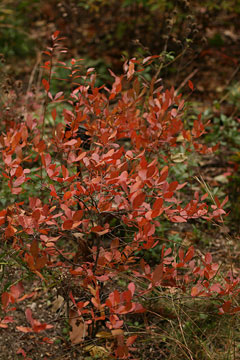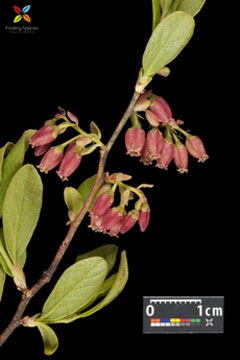 |
|
http://www.flickr.com/photos/53817483@N00/3003316991 |
 |
| http://www.findingspecies.org/ |
Translate this page:
Summary
Gaylussacia baccata, the black huckleberry, is a deciduous Shrub growing to 1 m (3ft 3in) in dry woods; closely resembling blueberry plants (Vaccinium species), it is grown in similar conditions. Plants spread quickly to form thickets in sunny woody areas.
The fruit is deliciously spicy and sweet; they can be eaten out of hand or used in pies, preserves etc. They can also be dried for later use. The dried fruit can be ground into a powder then mixed with cereal flours to make bread. The fruit is somewhat seedy. The fruit is about 8mm in diameter. Some medical uses.
Physical Characteristics

 Gaylussacia baccata is a deciduous Shrub growing to 1 m (3ft 3in) by 1 m (3ft 3in).
Gaylussacia baccata is a deciduous Shrub growing to 1 m (3ft 3in) by 1 m (3ft 3in).
See above for USDA hardiness. It is hardy to UK zone 6. It is in flower from May to June. The species is hermaphrodite (has both male and female organs).
Suitable for: light (sandy), medium (loamy) and heavy (clay) soils and prefers well-drained soil. Suitable pH: mildly acid soils and can grow in very acid soils.
It can grow in semi-shade (light woodland) or no shade. It prefers dry or moist soil.
UK Hardiness Map
US Hardiness Map
Synonyms
G. resinosa. Andromeda baccata. Vaccinium resinosum.
Plant Habitats
Woodland Garden Sunny Edge; Dappled Shade;
Edible Uses
Edible Parts: Fruit
Edible Uses:
Fruit - raw or cooked[2, 3, 55]. Deliciously spicy and sweet, they can be eaten out of hand or used in pies, preserves etc[183]. They can also be dried for later use[62]. The dried fruit can be ground into a powder then mixed with cereal flours to make bread[257]. The fruit is rather seedy[235]. The fruit is about 8mm in diameter[200].
References More on Edible Uses
Medicinal Uses
Plants For A Future can not take any responsibility for any adverse effects from the use of plants. Always seek advice from a professional before using a plant medicinally.
Astringent Dysentery Miscellany
An infusion of the leaves, or the bark, has been used in the treatment of dysentery[257]. An infusion of the leaves has been used in the treatment of Bright's disease[257].
References More on Medicinal Uses
The Bookshop: Edible Plant Books
Our Latest books on Perennial Plants For Food Forests and Permaculture Gardens in paperback or digital formats.

Edible Tropical Plants
Food Forest Plants for Hotter Conditions: 250+ Plants For Tropical Food Forests & Permaculture Gardens.
More

Edible Temperate Plants
Plants for Your Food Forest: 500 Plants for Temperate Food Forests & Permaculture Gardens.
More

More Books
PFAF have eight books available in paperback and digital formats. Browse the shop for more information.
Shop Now
Other Uses
References More on Other Uses
Cultivation details
Requires a lime-free moist peaty soil, thriving in sun or part shade[3, 182, 200]. Plants are hardy to about -15°c[200]. Occasionally cultivated for its edible fruit, there are some named varieties selected for their larger fruits[22, 46]. The small oval leaves are covered with globules on the underside from which a resinous gum is exuded[245]. The plant is heat tolerant in zones 7 through 1. (Plant Hardiness Zones show how well plants withstand cold winter temperatures.
Plant Heat Zones show when plants would start suffering from the heat.
The Plant Heat Zone map is based on the number of "heat days" experienced in a given area where the temperature climbs to over 86 degrees F (30°C).
At this temperature, many plants begin to suffer physiological damage. Heat Zones range from 1 (no heat days) to 12 (210 or more heat days).
For example Heat Zone. 11-1 indicates that the plant is heat tolerant in zones 11 through 1.) For polyculture design as well as the above-ground architecture (form - tree, shrub etc. and size shown above) information on the habit and root pattern is also useful and given here if available. The plant growth habit is a running thicket former forming a colony from shoots away from the crown spreading indefinitely [1-2]. The root pattern is suckering with new plants from underground runners away from the plant [1-2].
References Carbon Farming Information and Carbon Sequestration Information
Temperature Converter
Type a value in the Celsius field to convert the value to Fahrenheit:
Fahrenheit:
The PFAF Bookshop
Plants For A Future have a number of books available in paperback and digital form. Book titles include Edible Plants, Edible Perennials, Edible Trees,Edible Shrubs, Woodland Gardening, and Temperate Food Forest Plants. Our new book is Food Forest Plants For Hotter Conditions (Tropical and Sub-Tropical).
Shop Now
Plant Propagation
Seed - best sown in the autumn in a cold frame[200]. Seeds are short-lived and difficult to germinate. Stored seed requires 1 month warm stratification followed by 2 months cold[113]. When large enough to handle, prick the seedlings out into individual pots of lime-free compost and grow them on in light shade in a greenhouse or cold frame for at least their first winter. Plant out into their permanent positions in late spring or early summer when they are at least 15cm tall. Cuttings of half-ripe wood, July/August in a frame[200]. Layering. Division in spring.
Other Names
If available other names are mentioned here
Black huckleberry, common huckleberry
Native Range
NORTHERN AMERICA: United States, Connecticut, Indiana, Maine, Massachusetts, Michigan, New Hampshire, New Jersey, New York, Ohio, Pennsylvania, Rhode Island, Vermont, West Virginia, Illinois, Iowa (east), Minnesota (southeast), Missouri (east), Wisconsin, Alabama, Arkansas, Delaware, Georgia, Kentucky, Louisiana, Maryland, Mississippi, North Carolina, South Carolina, Tennessee, Virginia, Canada, Québec, Nova Scotia, Ontario, Prince Edward Island, New Brunswick, Newfoundland and Labrador,
Weed Potential
Right plant wrong place. We are currently updating this section.
Please note that a plant may be invasive in one area but may not in your area so it's worth checking.
Conservation Status
IUCN Red List of Threatened Plants Status :

Growth: S = slow M = medium F = fast. Soil: L = light (sandy) M = medium H = heavy (clay). pH: A = acid N = neutral B = basic (alkaline). Shade: F = full shade S = semi-shade N = no shade. Moisture: D = dry M = Moist We = wet Wa = water.
Now available:
Food Forest Plants for Mediterranean Conditions
350+ Perennial Plants For Mediterranean and Drier Food Forests and Permaculture Gardens.
[Paperback and eBook]
This is the third in Plants For A Future's series of plant guides for food forests tailored to
specific climate zones. Following volumes on temperate and tropical ecosystems, this book focuses
on species suited to Mediterranean conditions—regions with hot, dry summers and cool, wet winters,
often facing the added challenge of climate change.
Read More
Expert comment
Author
(Wangenh.)K.Koch.
Botanical References
1143200
Links / References
For a list of references used on this page please go here
Readers comment
| Add a comment |
|
If you have important information about this plant that may help other users please add a comment or link below. Only comments or links that are felt to be directly relevant to a plant will be included. If you think a comment/link or information contained on this page is inaccurate or misleading we would welcome your feedback at [email protected]. If you have questions about a plant please use the Forum on this website as we do not have the resources to answer questions ourselves.
* Please note: the comments by website users are not necessarily those held by PFAF and may give misleading or inaccurate information.
To leave a comment please Register or login here All comments need to be approved so will not appear immediately.
|
Subject : Gaylussacia baccata
|
|
|
|